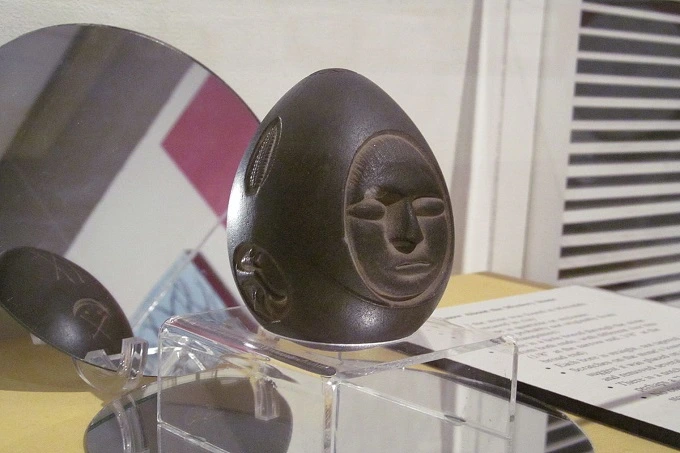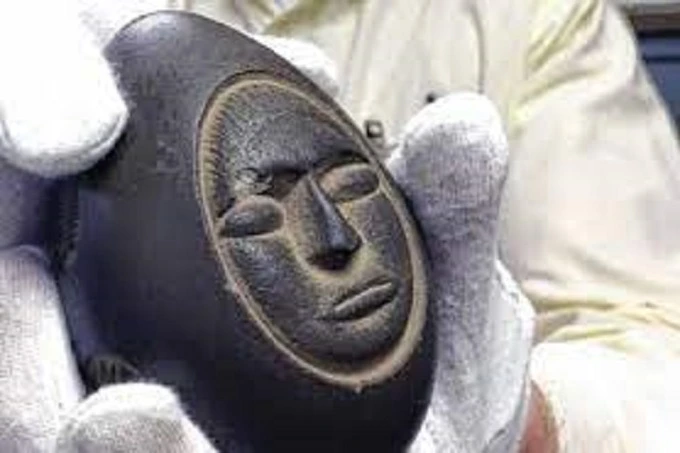The mysterious stone of Lake Winnipesaukee

The Meredith Stone, as it is also known, has every justification for being referred to be a strange artifact. Since its discovery in the late 19th century, this one-of-a-kind egg-shaped item has perplexed scientists. Even in this day and age, no one can definitively say what it is. What ideas do today’s experts provide to explain this phenomenon?
The dimensions of this artifact are relatively small, measuring around 10 centimetres in height and 6 centimeters across at its widest point. The surface of the stone has been carefully polished to a mirror-like smoothness. The way he has handled this situation provides considerably more questions than answers.
Dark quartzite, also known as quartz sandstone, was compressed and heated to extremely high temperatures to form this stone in the shape of an egg. According to all available evidence, it cannot have originated in the area. The stone’s surface has been painted with figures and symbols that are easy to make out. Scientists have spent a significant amount of time and effort over the course of many years attempting to solve the mystery of where the artifact came from and who might have created it.

In the year 1872, the mystery object was discovered. Seneca A. Ladd, a successful businessman at the time, was working in the construction industry in Meredith, New Hampshire. He was responsible for employing a team that was now constructing a fence around the property in question. During the course of their work, they came across an odd-looking lump of clay by chance. The interior contained a mysterious stone that was exquisitely adorned and was about the size of a goose egg while being covered in dirt.
On both sides of the stone, highly visible symbols have been carved into it. Some of these symbols include pictures of the moon and arrows. A wigwam that has four poles is depicted on the third side. A particular oval and a human face can be found on the fourth. The facial features have been cut into the stone so that they are flush with the surface of the material. It appears as though the lips are conveying an emotional state to the face that is being depicted.
There is a strong possibility that Native American culture was influential in creating the symbols that depict ears of corn and arrows that are crossed. In the eyes of some knowledgeable individuals, the combination represents some sort of peace agreement. The holes that were discovered in the stone both point to and suggest the same thoughts. They undergo a drilling process at both ends using a variety of drill bits of varying sizes. These holes, for instance, make it possible to attach a stone to a pole that serves as a boundary between different territories. The theory that the stone is some tool, weapon, or permanent tribal record is another hypothesis proposed regarding the origin of the object.
Seneca A. Ladd concluded that the Native Americans were the rightful owners of the stone at one point in time. There is some debate on the quality of the craftsmanship that was used to work the stone. The size of the holes that were drilled into the stone is inconsistent, and the holes do not have a conical shape. They have an extremely smooth inside, which leads one to believe that someone drilled holes in them using more modern equipment.
Unknown hands, most likely in the middle or late 1800s, were responsible for creating this egg-shaped artifact, which we know was manufactured for a fact. And ever since then, it has given historians cause for consternation for well over a century. A school of thought among experts in the field suggests the artifact most likely originated in Celtic history. Is this what people mean when they talk about the “thunderstone”?
The year 1931 saw the introduction of this concept. There is a possibility that the stone comes from Inuit or Celtic culture. A “thunderstone,” often called a “thunderstrike” or a “thunder ax,” is an artificial stone object that is typically wedge-shaped and resembles an ax blade. According to legend, the “thunderstone” fell from the heavens. This may explain why the stone was discovered in the clay clump.
There were frequently strange-looking stones in the fields where people lived many generations ago. In most cases, the peasants were under the impression that this was a divine punishment in the form of heavenly lightning and thunder.
Although the mysterious Meredith Stone is not the only one of its sort, to our knowledge, it is unmatched anywhere else in the United States. The Ladd family generously presented this stone to the New Hampshire Historical Society as a mark of their appreciation. It has been donated to the regional museum to be analyzed there. It must be a really special occasion for you to be able to stare an egg straight in the eye. Will someone ever figure out what the symbols on this object mean and end the mystery surrounding one of the most peculiar historical discoveries?




